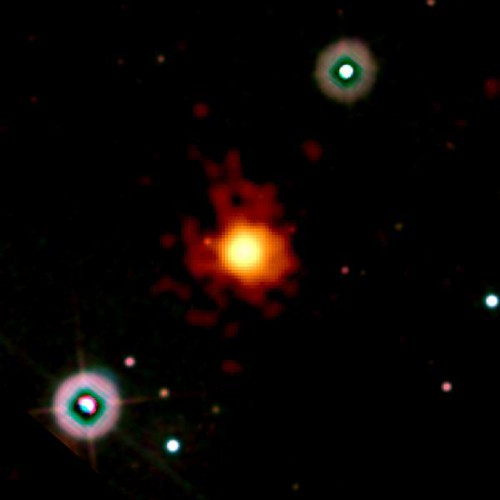Far Out

Tommy Chong of Cheech & Chong said it best: "Far out, man!"
I wonder if somebody at NASA’s Goddard Space Flight Center said something similar about this blast from the past, maybe 13 billion light years away:
NASA’s Swift satellite and an international team of astronomers have found a gamma-ray burst from a star that died when the universe was only 630 million years old, or less than five percent of its present age. The event, dubbed GRB 090423, is the most distant cosmic explosion ever seen.
"Swift was designed to catch these very distant bursts," said Swift lead scientist Neil Gehrels at NASA’s Goddard Space Flight Center in Greenbelt, Md. "The incredible distance to this burst exceeded our greatest expectations — it was a true blast from the past."
At 3:55 a.m. EDT on April 23, Swift detected a ten-second-long gamma-ray burst of modest brightness. It quickly pivoted to bring its ultraviolet/optical and X-ray telescopes to observe the burst location. Swift saw a fading X-ray afterglow but none in visible light.
"The burst most likely arose from the explosion of a massive star," said Derek Fox at Pennsylvania State University. "We’re seeing the demise of a star — and probably the birth of a black hole — in one of the universe’s earliest stellar generations."
Gamma-ray bursts are the universe’s most luminous explosions. Most occur when massive stars run out of nuclear fuel. As their cores collapse into a black hole or neutron star, gas jets — driven by processes not fully understood — punch through the star and blast into space. There, they strike gas previously shed by the star and heat it, which generates short-lived afterglows in many wavelengths.
"The lack of visible light alone suggested this could be a very distant object," explained team member Edo Berger of Harvard University.
Beyond a certain distance, the expansion of the universe shifts all optical emission into longer infrared wavelengths. While a star’s ultraviolet light could be similarly shifted into the visible region, ultraviolet-absorbing hydrogen gas grows thicker at earlier times. "If you look far enough away, you can’t see visible light from any object," he noted.
Within three hours of the burst, Nial Tanvir at the University of Leicester, U.K., and his colleagues reported detection of an infrared source at the Swift position using the United Kingdom Infrared Telescope on Mauna Kea, Hawaii. "Burst afterglows provide us with the most information about the exploded star and its environs," Tanvir said. "But because afterglows fade out so fast, we must target them quickly."
At the same time, Fox led an effort to obtain infrared images of the afterglow using the Gemini North Telescope on Mauna Kea. The source appeared in longer-wavelength images but was absent in an image taken at the shortest wavelength of 1 micron. This "drop out" corresponded to a distance of about 13 billion light-years.
Here’s a video of what a gamma ray burst would look like up-close (Credit: NASA/Swift/Cruz deWild):